Marius Cordts
AGO: Adaptive Grounding for Open World 3D Occupancy Prediction
Apr 14, 2025Abstract:Open-world 3D semantic occupancy prediction aims to generate a voxelized 3D representation from sensor inputs while recognizing both known and unknown objects. Transferring open-vocabulary knowledge from vision-language models (VLMs) offers a promising direction but remains challenging. However, methods based on VLM-derived 2D pseudo-labels with traditional supervision are limited by a predefined label space and lack general prediction capabilities. Direct alignment with pretrained image embeddings, on the other hand, fails to achieve reliable performance due to often inconsistent image and text representations in VLMs. To address these challenges, we propose AGO, a novel 3D occupancy prediction framework with adaptive grounding to handle diverse open-world scenarios. AGO first encodes surrounding images and class prompts into 3D and text embeddings, respectively, leveraging similarity-based grounding training with 3D pseudo-labels. Additionally, a modality adapter maps 3D embeddings into a space aligned with VLM-derived image embeddings, reducing modality gaps. Experiments on Occ3D-nuScenes show that AGO improves unknown object prediction in zero-shot and few-shot transfer while achieving state-of-the-art closed-world self-supervised performance, surpassing prior methods by 4.09 mIoU.
EMPERROR: A Flexible Generative Perception Error Model for Probing Self-Driving Planners
Nov 12, 2024



Abstract:To handle the complexities of real-world traffic, learning planners for self-driving from data is a promising direction. While recent approaches have shown great progress, they typically assume a setting in which the ground-truth world state is available as input. However, when deployed, planning needs to be robust to the long-tail of errors incurred by a noisy perception system, which is often neglected in evaluation. To address this, previous work has proposed drawing adversarial samples from a perception error model (PEM) mimicking the noise characteristics of a target object detector. However, these methods use simple PEMs that fail to accurately capture all failure modes of detection. In this paper, we present EMPERROR, a novel transformer-based generative PEM, apply it to stress-test an imitation learning (IL)-based planner and show that it imitates modern detectors more faithfully than previous work. Furthermore, it is able to produce realistic noisy inputs that increase the planner's collision rate by up to 85%, demonstrating its utility as a valuable tool for a more complete evaluation of self-driving planners.
DualAD: Disentangling the Dynamic and Static World for End-to-End Driving
Jun 10, 2024Abstract:State-of-the-art approaches for autonomous driving integrate multiple sub-tasks of the overall driving task into a single pipeline that can be trained in an end-to-end fashion by passing latent representations between the different modules. In contrast to previous approaches that rely on a unified grid to represent the belief state of the scene, we propose dedicated representations to disentangle dynamic agents and static scene elements. This allows us to explicitly compensate for the effect of both ego and object motion between consecutive time steps and to flexibly propagate the belief state through time. Furthermore, dynamic objects can not only attend to the input camera images, but also directly benefit from the inferred static scene structure via a novel dynamic-static cross-attention. Extensive experiments on the challenging nuScenes benchmark demonstrate the benefits of the proposed dual-stream design, especially for modelling highly dynamic agents in the scene, and highlight the improved temporal consistency of our approach. Our method titled DualAD not only outperforms independently trained single-task networks, but also improves over previous state-of-the-art end-to-end models by a large margin on all tasks along the functional chain of driving.
ADA-Track: End-to-End Multi-Camera 3D Multi-Object Tracking with Alternating Detection and Association
May 14, 2024Abstract:Many query-based approaches for 3D Multi-Object Tracking (MOT) adopt the tracking-by-attention paradigm, utilizing track queries for identity-consistent detection and object queries for identity-agnostic track spawning. Tracking-by-attention, however, entangles detection and tracking queries in one embedding for both the detection and tracking task, which is sub-optimal. Other approaches resemble the tracking-by-detection paradigm, detecting objects using decoupled track and detection queries followed by a subsequent association. These methods, however, do not leverage synergies between the detection and association task. Combining the strengths of both paradigms, we introduce ADA-Track, a novel end-to-end framework for 3D MOT from multi-view cameras. We introduce a learnable data association module based on edge-augmented cross-attention, leveraging appearance and geometric features. Furthermore, we integrate this association module into the decoder layer of a DETR-based 3D detector, enabling simultaneous DETR-like query-to-image cross-attention for detection and query-to-query cross-attention for data association. By stacking these decoder layers, queries are refined for the detection and association task alternately, effectively harnessing the task dependencies. We evaluate our method on the nuScenes dataset and demonstrate the advantage of our approach compared to the two previous paradigms. Code is available at https://github.com/dsx0511/ADA-Track.
3DMOTFormer: Graph Transformer for Online 3D Multi-Object Tracking
Aug 12, 2023Abstract:Tracking 3D objects accurately and consistently is crucial for autonomous vehicles, enabling more reliable downstream tasks such as trajectory prediction and motion planning. Based on the substantial progress in object detection in recent years, the tracking-by-detection paradigm has become a popular choice due to its simplicity and efficiency. State-of-the-art 3D multi-object tracking (MOT) approaches typically rely on non-learned model-based algorithms such as Kalman Filter but require many manually tuned parameters. On the other hand, learning-based approaches face the problem of adapting the training to the online setting, leading to inevitable distribution mismatch between training and inference as well as suboptimal performance. In this work, we propose 3DMOTFormer, a learned geometry-based 3D MOT framework building upon the transformer architecture. We use an Edge-Augmented Graph Transformer to reason on the track-detection bipartite graph frame-by-frame and conduct data association via edge classification. To reduce the distribution mismatch between training and inference, we propose a novel online training strategy with an autoregressive and recurrent forward pass as well as sequential batch optimization. Using CenterPoint detections, our approach achieves 71.2% and 68.2% AMOTA on the nuScenes validation and test split, respectively. In addition, a trained 3DMOTFormer model generalizes well across different object detectors. Code is available at: https://github.com/dsx0511/3DMOTFormer.
PowerBEV: A Powerful Yet Lightweight Framework for Instance Prediction in Bird's-Eye View
Jun 19, 2023Abstract:Accurately perceiving instances and predicting their future motion are key tasks for autonomous vehicles, enabling them to navigate safely in complex urban traffic. While bird's-eye view (BEV) representations are commonplace in perception for autonomous driving, their potential in a motion prediction setting is less explored. Existing approaches for BEV instance prediction from surround cameras rely on a multi-task auto-regressive setup coupled with complex post-processing to predict future instances in a spatio-temporally consistent manner. In this paper, we depart from this paradigm and propose an efficient novel end-to-end framework named POWERBEV, which differs in several design choices aimed at reducing the inherent redundancy in previous methods. First, rather than predicting the future in an auto-regressive fashion, POWERBEV uses a parallel, multi-scale module built from lightweight 2D convolutional networks. Second, we show that segmentation and centripetal backward flow are sufficient for prediction, simplifying previous multi-task objectives by eliminating redundant output modalities. Building on this output representation, we propose a simple, flow warping-based post-processing approach which produces more stable instance associations across time. Through this lightweight yet powerful design, POWERBEV outperforms state-of-the-art baselines on the NuScenes Dataset and poses an alternative paradigm for BEV instance prediction. We made our code publicly available at: https://github.com/EdwardLeeLPZ/PowerBEV.
Structural Knowledge Distillation for Object Detection
Nov 23, 2022Abstract:Knowledge Distillation (KD) is a well-known training paradigm in deep neural networks where knowledge acquired by a large teacher model is transferred to a small student. KD has proven to be an effective technique to significantly improve the student's performance for various tasks including object detection. As such, KD techniques mostly rely on guidance at the intermediate feature level, which is typically implemented by minimizing an lp-norm distance between teacher and student activations during training. In this paper, we propose a replacement for the pixel-wise independent lp-norm based on the structural similarity (SSIM). By taking into account additional contrast and structural cues, feature importance, correlation and spatial dependence in the feature space are considered in the loss formulation. Extensive experiments on MSCOCO demonstrate the effectiveness of our method across different training schemes and architectures. Our method adds only little computational overhead, is straightforward to implement and at the same time it significantly outperforms the standard lp-norms. Moreover, more complex state-of-the-art KD methods using attention-based sampling mechanisms are outperformed, including a +3.5 AP gain using a Faster R-CNN R-50 compared to a vanilla model.
Cityscapes 3D: Dataset and Benchmark for 9 DoF Vehicle Detection
Jun 14, 2020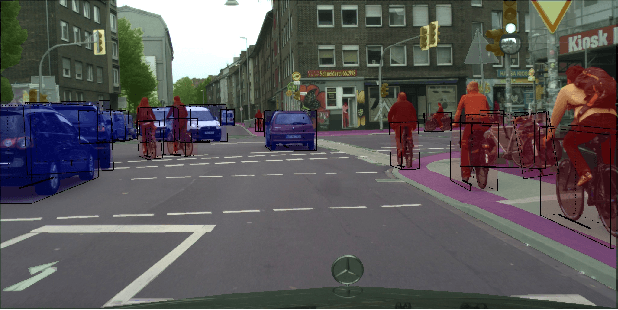
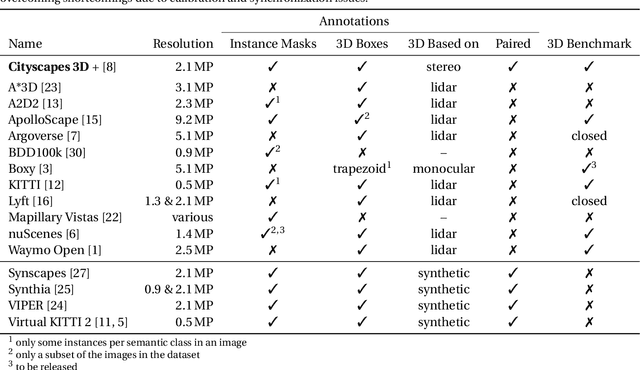
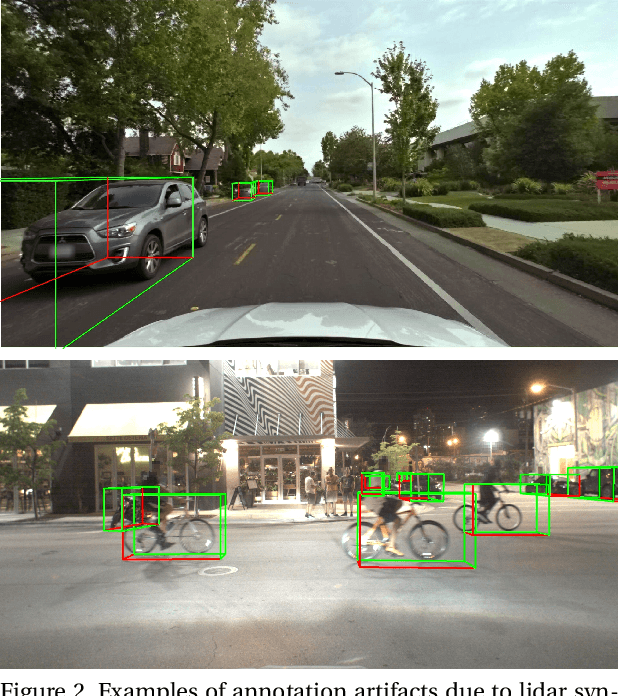
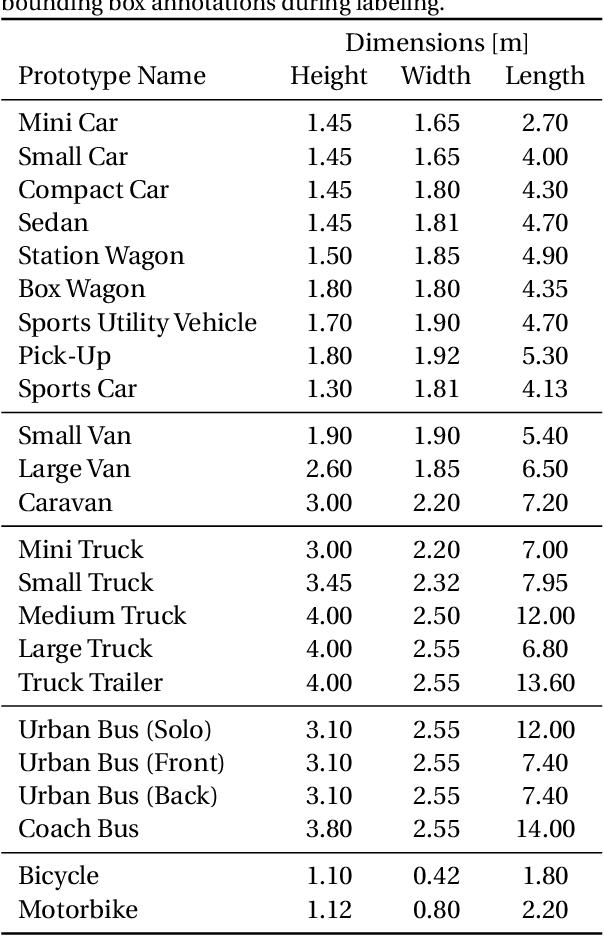
Abstract:Detecting vehicles and representing their position and orientation in the three dimensional space is a key technology for autonomous driving. Recently, methods for 3D vehicle detection solely based on monocular RGB images gained popularity. In order to facilitate this task as well as to compare and drive state-of-the-art methods, several new datasets and benchmarks have been published. Ground truth annotations of vehicles are usually obtained using lidar point clouds, which often induces errors due to imperfect calibration or synchronization between both sensors. To this end, we propose Cityscapes 3D, extending the original Cityscapes dataset with 3D bounding box annotations for all types of vehicles. In contrast to existing datasets, our 3D annotations were labeled using stereo RGB images only and capture all nine degrees of freedom. This leads to a pixel-accurate reprojection in the RGB image and a higher range of annotations compared to lidar-based approaches. In order to ease multitask learning, we provide a pairing of 2D instance segments with 3D bounding boxes. In addition, we complement the Cityscapes benchmark suite with 3D vehicle detection based on the new annotations as well as metrics presented in this work. Dataset and benchmark are available online.
The Stixel world: A medium-level representation of traffic scenes
Apr 02, 2017

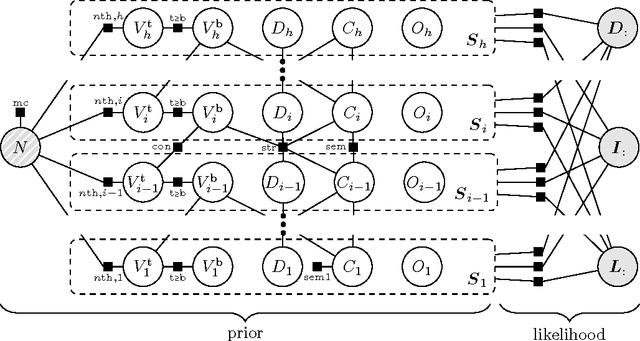

Abstract:Recent progress in advanced driver assistance systems and the race towards autonomous vehicles is mainly driven by two factors: (1) increasingly sophisticated algorithms that interpret the environment around the vehicle and react accordingly, and (2) the continuous improvements of sensor technology itself. In terms of cameras, these improvements typically include higher spatial resolution, which as a consequence requires more data to be processed. The trend to add multiple cameras to cover the entire surrounding of the vehicle is not conducive in that matter. At the same time, an increasing number of special purpose algorithms need access to the sensor input data to correctly interpret the various complex situations that can occur, particularly in urban traffic. By observing those trends, it becomes clear that a key challenge for vision architectures in intelligent vehicles is to share computational resources. We believe this challenge should be faced by introducing a representation of the sensory data that provides compressed and structured access to all relevant visual content of the scene. The Stixel World discussed in this paper is such a representation. It is a medium-level model of the environment that is specifically designed to compress information about obstacles by leveraging the typical layout of outdoor traffic scenes. It has proven useful for a multitude of automotive vision applications, including object detection, tracking, segmentation, and mapping. In this paper, we summarize the ideas behind the model and generalize it to take into account multiple dense input streams: the image itself, stereo depth maps, and semantic class probability maps that can be generated, e.g., by CNNs. Our generalization is embedded into a novel mathematical formulation for the Stixel model. We further sketch how the free parameters of the model can be learned using structured SVMs.
Pixel-level Encoding and Depth Layering for Instance-level Semantic Labeling
Jul 14, 2016
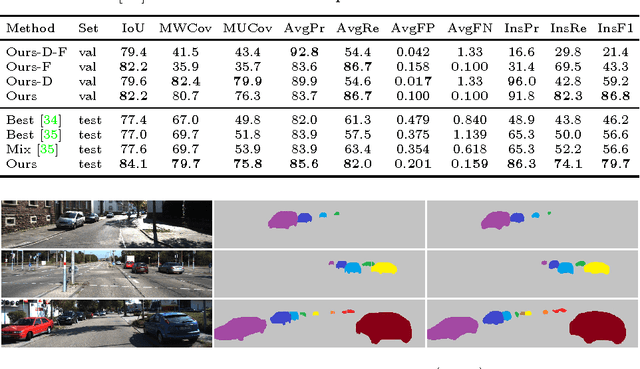
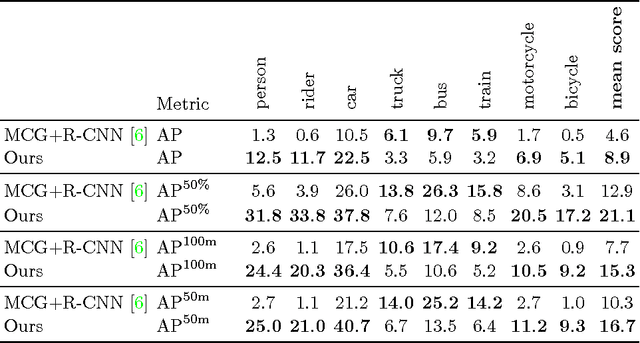
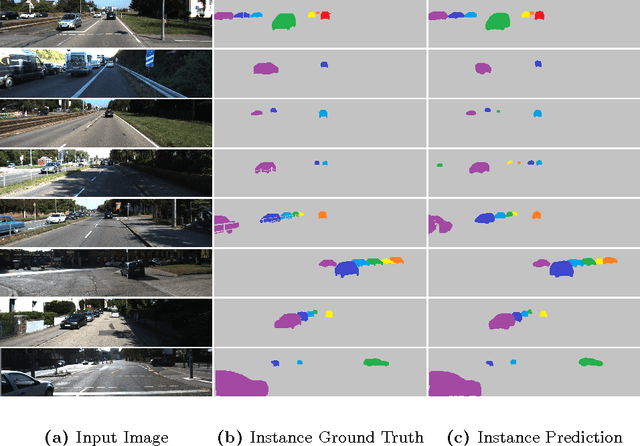
Abstract:Recent approaches for instance-aware semantic labeling have augmented convolutional neural networks (CNNs) with complex multi-task architectures or computationally expensive graphical models. We present a method that leverages a fully convolutional network (FCN) to predict semantic labels, depth and an instance-based encoding using each pixel's direction towards its corresponding instance center. Subsequently, we apply low-level computer vision techniques to generate state-of-the-art instance segmentation on the street scene datasets KITTI and Cityscapes. Our approach outperforms existing works by a large margin and can additionally predict absolute distances of individual instances from a monocular image as well as a pixel-level semantic labeling.
 Add to Chrome
Add to Chrome Add to Firefox
Add to Firefox Add to Edge
Add to Edge